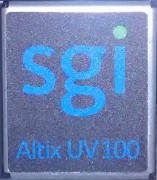I was getting a "firmware too old" message from numastatd at startup, so I thought it would be a good idea to update it to 1.44.0 which came with 6.5.30.
It turns out that this combination of -003 motherboard and 1.44.0 L1 firmware renders the system unbootable. Won't respond to power button, verbal abuse, nothing.
The procedure to reverse this is quite simple, though
Remove the machine's side panel. Somewhere near the SCSI connector on the motherboard you will find an RS232 port, attach a null-modem cable to it.
On the other machine, start a terminal emulator ('cu' works well), set it to 38400 8N1 (e.g. 'cu -l /dev/your_serial_port -s 38400').
As soon as you plug in the power cable on the Fuel, you should be greeted by a prompt:
The following entries in the log appeared at the time of the update:
If you try to issue a power up command, you will receive this lovely message:
Resetting the NVRAM didn't help, so I decided to boot the other L1 image.
(if your L1 booted from image B, enter "flash default a" instead)
After this, everything works normally:
If anyone has the newest 1.48.0 L1 image, I could give it a try to see whether they've fixed this or not
It turns out that this combination of -003 motherboard and 1.44.0 L1 firmware renders the system unbootable. Won't respond to power button, verbal abuse, nothing.
The procedure to reverse this is quite simple, though

Remove the machine's side panel. Somewhere near the SCSI connector on the motherboard you will find an RS232 port, attach a null-modem cable to it.
On the other machine, start a terminal emulator ('cu' works well), set it to 38400 8N1 (e.g. 'cu -l /dev/your_serial_port -s 38400').
As soon as you plug in the power cable on the Fuel, you should be greeted by a prompt:
Code: Select all
ALERT: Error reading the display I/O expander, no acknowledge
SGI SN1 L1 Controller
Firmware Image A: Rev. 1.44.0, Built 07/17/2006 18:19:54
001?01-L1>
The following entries in the log appeared at the time of the update:
Code: Select all
09/29/09 21:21:28 L1 booting 1.44.0
09/29/09 21:21:28 vram checksum error - initializing core data.
09/29/09 21:21:28 ALERT: Error reading the display I/O expander, no acknowledge
09/29/09 21:21:28 ** fixing invalid SSN value
If you try to issue a power up command, you will receive this lovely message:
Code: Select all
001?01-L1>pwr up
ERROR: no power supplies available.
Resetting the NVRAM didn't help, so I decided to boot the other L1 image.
Code: Select all
001?01-L1>flash status
Flash image A currently booted
Image Status Revision Built
----- ------------- ---------- -----
A default 1.44.0 07/17/2006 18:19:54
B valid 1.10.12 02/01/2002 14:40:22
001?01-L1>flash default b
(if your L1 booted from image B, enter "flash default a" instead)
Code: Select all
001?01-L1>reboot_l1
After this, everything works normally:
Code: Select all
SGI SN1 L1 Controller
Firmware Image B: Rev. 1.10.12, Built 02/01/2002 14:40:22
001a01-L1>flash status
Flash image B currently booted
Image Status Revision Built
----- ------------- ---------- -----
A valid 1.44.0 07/17/2006 18:19:54
B user default 1.10.12 02/01/2002 14:40:22
If anyone has the newest 1.48.0 L1 image, I could give it a try to see whether they've fixed this or not












 (single-CM)
(single-CM)

 <>
<>


 x2+
x2+

 x2
x2
 x2+
x2+


 machine.
machine.